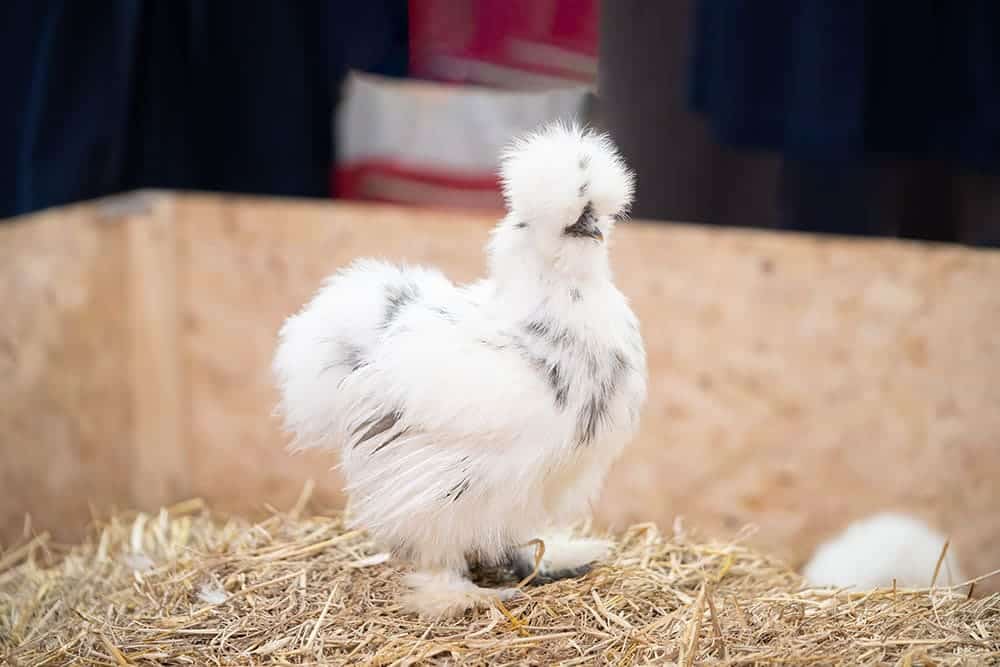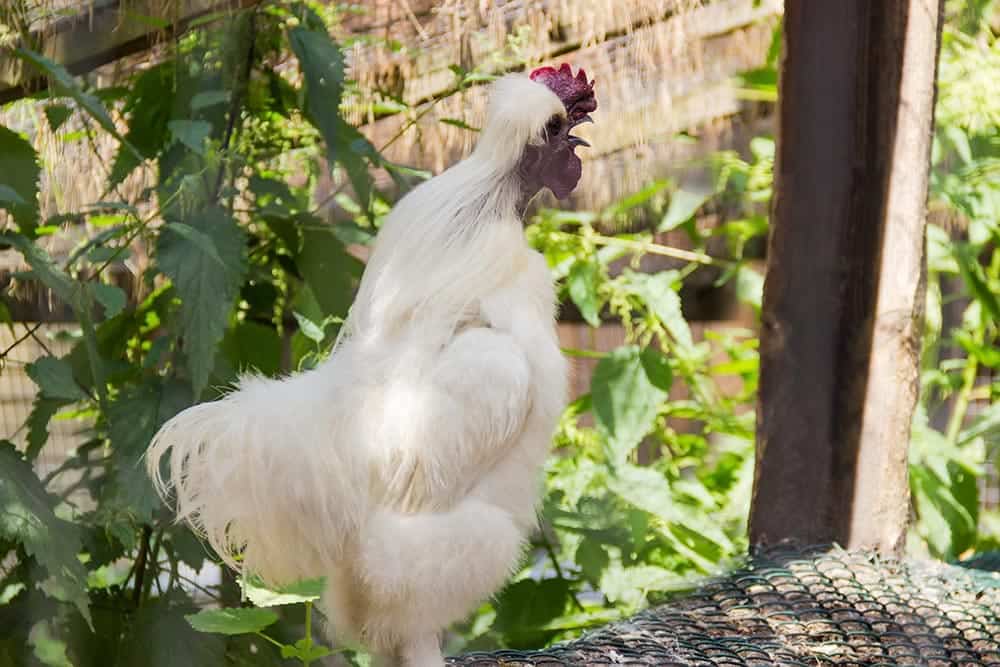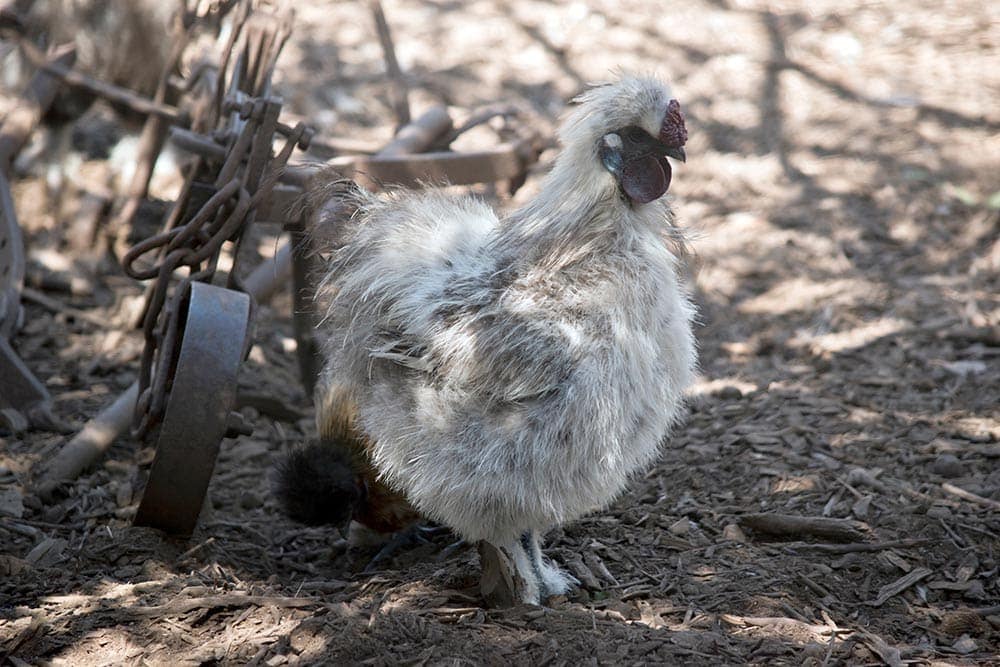Silkie roosters are popular for their unique appearance. All roosters crow, regardless of their breed. Silkie roosters usually begin crowing at about 4-5 months of age. Just because all Silkie roosters can crow doesn’t mean they all start to crow at the same age. Some are known to start crowing as young as two months, while others may not crow until well after a year old.
Unlike other breeds of roosters, Silkies are much less likely to crow if they are housed with other mature roosters. Their crow also sounds a bit different, sounding more like a Tarzan call or a yodel than a traditional “cock-a-doodle-doo.”

Frequency of Silkie Rooster Crowing
Silkie roosters don’t crow with the same frequency as other breeds of roosters. Most of their vocalization occurs early in the morning and late in the evening. If you are keeping multiple roosters together, you may find that only the dominant male crows, while your other roosters stay quiet. Solitary Silkie roosters often don’t crow at all.
There is no set frequency with which Silkie roosters should or shouldn’t crow. This often depends on the personality of the individual rooster, along with other factors in their environment.
Preventing Silkie Rooster Crowing
If you find your Silkie rooster is waking you up in the middle of the night with his loud crowing, there is a way to stop it. Silkie roosters crow while sitting on top of the roost. Picking him off the roost and placing him in a dark private cage will help him rest relatively quiet until morning. If your rooster has been handled as a chick, he shouldn’t be difficult to catch.
Do Silkie Hens Crow?
While crowing is normally attributed to roosters, if you’re Silkie hen is crowing, rest assured that it’s not your imagination. Any breed of hen can crow. They don’t usually do it, but they all can.
The usual reason hens crow is when they have lived with a rooster for most of their lives, and for one reason or another, the rooster no longer resides with them. Sometimes a hen will decide to take the rooster’s place and start crowing. It can also be a show of dominance from one hen to another, a way of showing that she is the “top hen” in the coop.

Are Silkie Roosters Aggressive?
The first question people ask when getting a rooster is, “How noisy will he be?” The second question is almost always related to aggression. And there’s a good reason for it.
While Silkie roosters are smaller and easier to handle than many other breeds, the fact remains that they are roosters. As with many species, intact males can be territorial and aggressive to other chickens and to you.
Silkie roosters are a less aggressive breed of chicken, and they are mostly known for having a fairly calm temperament. Keeping only one rooster at a time can help reduce incidences of aggression, but it doesn’t mean they won’t happen.
Do Silkie Roosters Grow Spurs?
If you’re new to rooster ownership, the term “spur” might make you think of sharp, metal objects attached to the back of a pair of cowboy boots. While roosters don’t wear cowboy boots, they do grow spurs, and they are exactly the same as the image you’ve just conjured up.
Rooster spurs are sharp, pointy growths that stick out from the back of their heels, and like other breeds of roosters, Silkies grow them. The length and sharpness of these spurs vary between different birds, but you may want to stay out of range of their kicks.

Do Silkies Grow Combs?
Purebred silkies will not grow traditional red rooster combs. They will be walnut combs that are black or dark purple. It’s part of what makes Silkie roosters easily distinguished from other breeds. This comb, along with their fuzzy “fur,” gives them their unique appearance.
Some Silkie roosters grow combs that are so small they are covered up by their fur. If you look closely, however, you will find that a comb is still present.
How Many Roosters Should I Keep?
In a chicken coop, the rule of thumb is to have one rooster for every ten hens. So, if you are keeping a small coop of backyard chickens in town, you should probably stick to just one rooster.
The problem with keeping more than one rooster is that they become aggressive and territorial, both over space and over the hens. When establishing who’s in charge (i.e., Who is the dominant rooster), they can be absolutely ruthless. Not only can they do considerable damage to their coop, but roosters who get too aggressive are capable of killing each other.
- Other issues with having multiple roosters include the problem of over-mating. This causes considerable stress for your hens and can harm their long-term health.
- More than one rooster will also mean you have more than one crowing, which in turn means your coop will be noisier.
- If you have a flock of more than ten hens and require more than one rooster, you should be experienced at raising chickens and know how to avoid problems within your flock.

Summary
Silkie roosters can and do crow, but they are quieter than other breeds of roosters. Their unique looks and small stature make them one of the more popular breeds for backyard chicken coops. They are also less aggressive than other breeds and are a good choice for beginners and inexperienced handlers.
Featured Image Credit: Susan Flashman, Shutterstock
